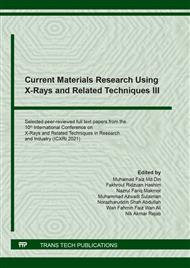p.612
p.621
p.626
p.633
p.639
p.645
p.651
p.658
p.664
Interfacial Transition Zone (ITZ) Study of Concrete with Polyethylene Terephthalate (PET) Plastic
Abstract:
Concrete is unquestionably the most desirable construction material, but, like any coin, italso has a negative side. In one way or another, the raw materials used in the production of concretehave a negative impact on the environment. Cement production releases carbon dioxide into theatmosphere, while aggregate production releases dust. The geology of the region where coarseaggregates were mined is also influenced by their extraction. Natural fine aggregates were replacedwith polyethylene terephthalate (PET) bottles in this analysis. PET Plastic aggregates wereproduced by little cutting of waste plastic bottle. Plastic is the most serious environmental problem,and it is having a rapid effect. Shredded waste plastic was used in concrete as a partial substitute fortraditional fine aggregate at 0%, 5%, 10%, 15%, and 20% by weight. The aim of this research wasto determine the compressive strength, microstructure of concrete, and the interfacial transition zoneof concrete (ITZ). The concrete with 5% fine aggregate replacement showed a possible outcome of21 MPa compressive strength, the control mix had the lowest percentage of 1.3 percent, and theconcrete with 20% PET plastic had the highest percentage of 9.8 percent. It can be concluded thatrecycled plastic aggregates can be used to replace fine aggregate in concrete up to 5% of thereplacement and can be used in non-load bearing structures where lightweight materials arepreferred
Info:
Periodical:
Pages:
639-644
Citation:
Online since:
January 2022
Price:
Сopyright:
© 2022 Trans Tech Publications Ltd. All Rights Reserved
Share:
Citation:


